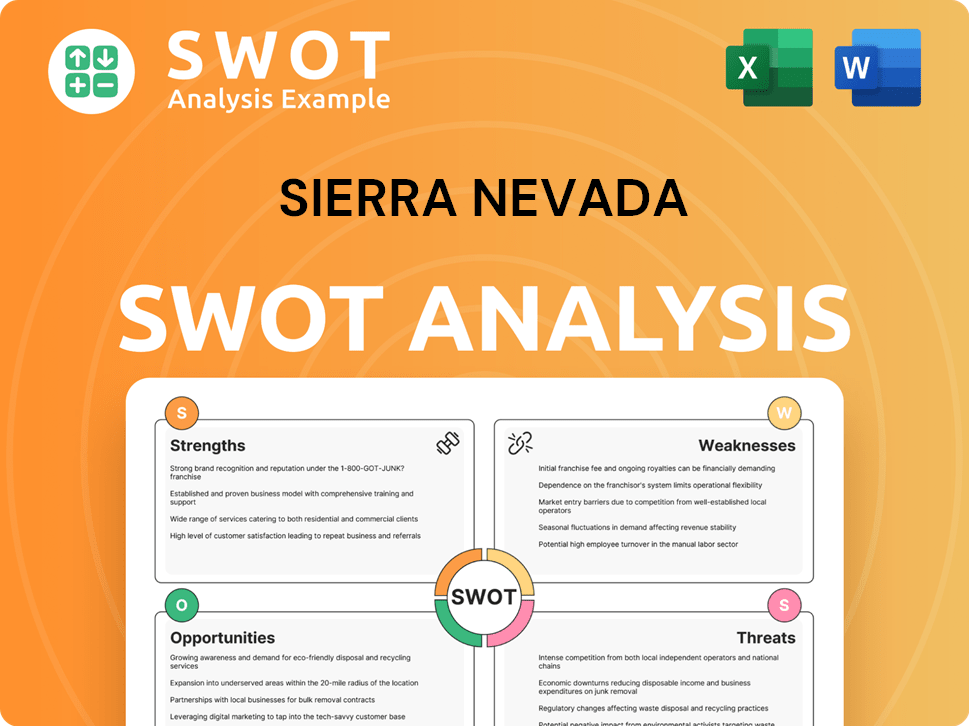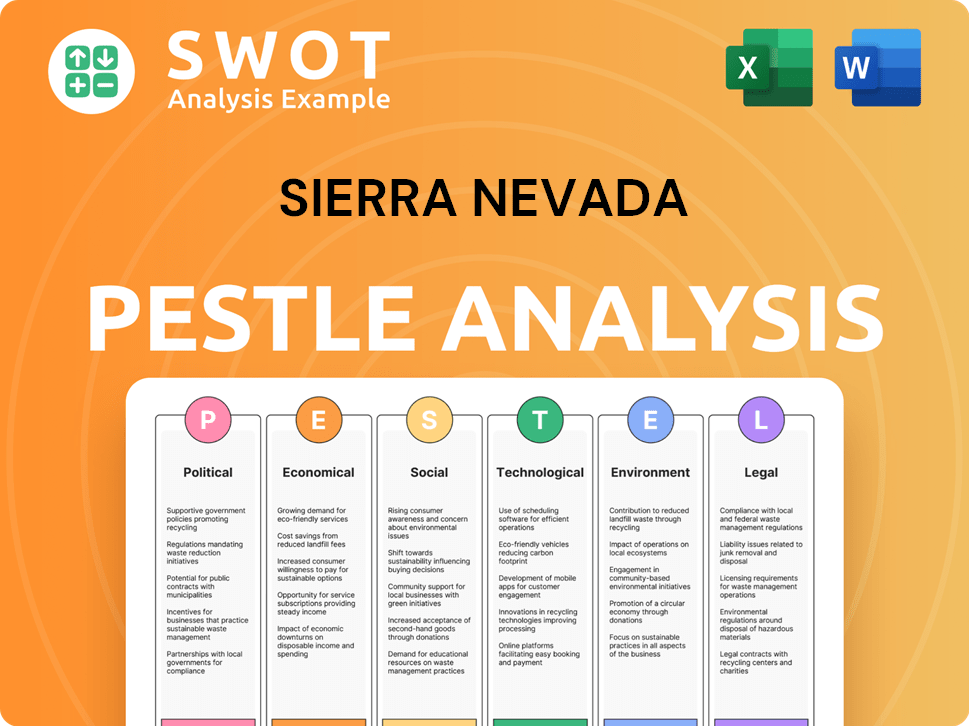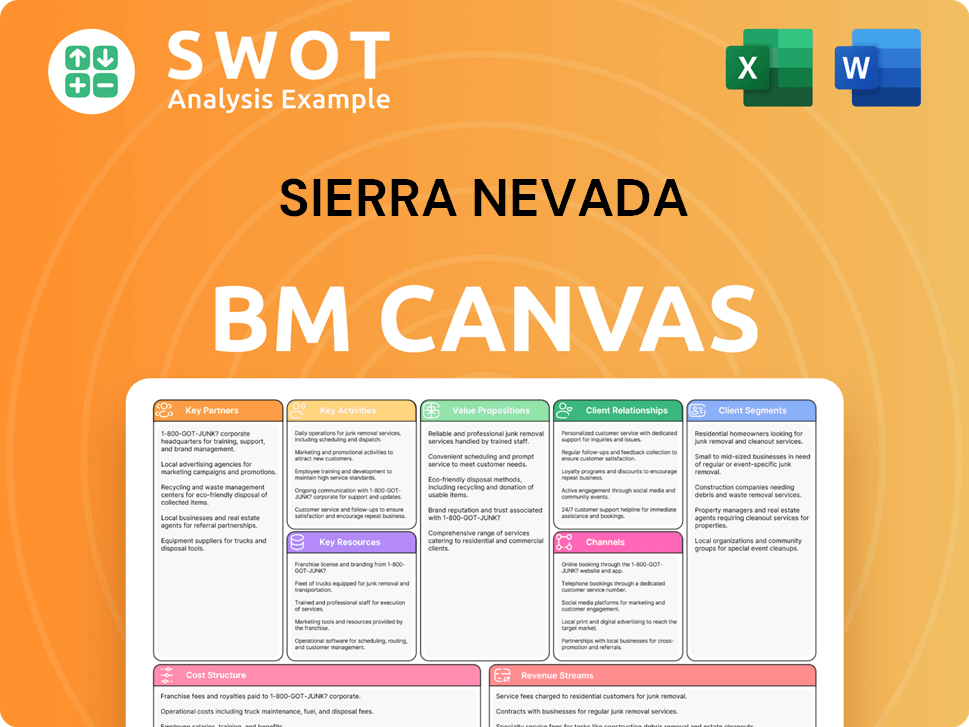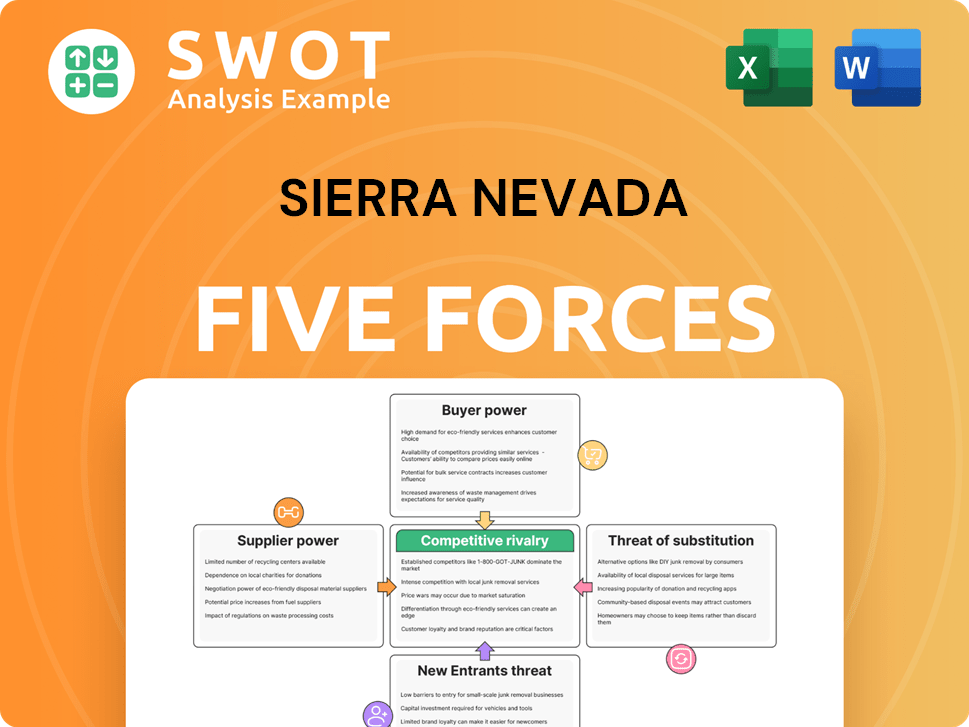Sierra Nevada Bundle
How Does Sierra Nevada Corporation Thrive in a Complex Market?
In the high-stakes world of aerospace and national security, Sierra Nevada SWOT Analysis is a key player. Founded in 1963, SNC has evolved from a small firm into a global leader, consistently pushing technological boundaries. But what does its competitive landscape look like?

This exploration delves into the intricate Sierra Nevada competitive landscape, identifying its key Sierra Nevada competitors and the strategies that fuel its success. We'll examine its unique strengths and weaknesses, providing a detailed Sierra Nevada market analysis to understand its position in a dynamic industry. Understanding the competitive dynamics is crucial for anyone looking to understand the future of this innovative company.
Where Does Sierra Nevada’ Stand in the Current Market?
SNC's core operations revolve around advanced electronic systems, integrated aircraft solutions, and spacecraft. As a private entity, it focuses on specialized intelligence, surveillance, and reconnaissance (ISR) aircraft, satellite systems, and electronic warfare capabilities. Its value proposition lies in providing innovative, mission-critical solutions primarily to governmental agencies like NASA and the Department of Defense, along with select international partners, establishing a strong foothold in the aerospace and national security sectors.
The company has strategically positioned itself as a prime contractor and integrator, moving beyond its origins as a component supplier. This shift has allowed SNC to undertake larger, more complex projects, enhancing its reputation for innovation and reliability. A prime example is its work on the Dream Chaser spaceplane, which highlights its ambition in commercial space transportation and resupply missions. This evolution underscores SNC's commitment to expanding its capabilities and market presence.
Financially, while SNC doesn't release public financial statements, industry analysts recognize its substantial revenue and operational scale. The company consistently secures significant government contracts, such as the recent $713 million contract in 2024 for the Dream Chaser vehicle, indicating its robust financial health and strong market standing. SNC maintains a particularly strong position in specialized aerospace modifications and small to medium-sized satellite systems, while facing competition in broader aerospace manufacturing.
SNC holds a strong market position in the aerospace and national security industries. While specific market share figures for private entities are often not publicly disclosed, SNC is a key player in its target segments. The company's focus on specialized ISR aircraft, satellite systems, and electronic warfare capabilities contributes to its competitive advantage.
SNC's primary customer segments are highly specialized, focusing on defense, space, and secure communications. These include governmental agencies like NASA and the Department of Defense, as well as select international partners. This targeted approach allows SNC to tailor its products and services to meet specific needs within these critical sectors.
Over time, SNC has strategically shifted its positioning to emphasize its role as a prime contractor and integrator for complex, mission-critical systems. This evolution has allowed the company to take on larger, more intricate projects. The Dream Chaser spaceplane project is a significant example of SNC's ambitious push into commercial space transportation and resupply missions.
SNC's financial performance is robust, underscored by its consistent securing of significant government contracts. The recent $713 million contract for the Dream Chaser in 2024 is a testament to its financial health. Industry analysts acknowledge SNC's substantial revenue and operational scale, placing it among the top defense and aerospace contractors.
The Sierra Nevada competitive landscape includes both public and private companies in the aerospace and defense sectors. Key Sierra Nevada competitors include major players like Lockheed Martin, Boeing, and Northrop Grumman. SNC's focus on specialized areas like ISR aircraft and satellite systems allows it to compete effectively.
- Lockheed Martin: A major competitor in aerospace and defense, offering a wide range of products and services.
- Boeing: Another significant competitor, with a strong presence in both defense and commercial aerospace.
- Northrop Grumman: Competes in areas such as advanced electronic systems and spacecraft.
- Other Private Companies: Compete in specific segments, such as satellite systems and aerospace modifications.
Sierra Nevada SWOT Analysis
- Complete SWOT Breakdown
- Fully Customizable
- Editable in Excel & Word
- Professional Formatting
- Investor-Ready Format

Who Are the Main Competitors Challenging Sierra Nevada?
The Sierra Nevada competitive landscape is characterized by intense competition across various sectors, including aerospace, defense, and space technologies. This environment demands that the company continually innovate and adapt to maintain its market position. Understanding the key players and their strategies is crucial for assessing the challenges and opportunities SNC faces.
SNC's market analysis reveals a dynamic interplay of established giants and emerging firms. The company competes not only with large defense contractors but also with specialized entities in the space and ISR sectors. This multifaceted competition requires SNC to leverage its strengths in technological innovation, cost-effectiveness, and proven performance to secure contracts and expand its market share.
The competitive dynamics within the aerospace and defense industries are significantly influenced by government contracts and technological advancements. SNC must navigate these complexities to remain competitive. The company's ability to adapt to changing market conditions and leverage its core competencies is essential for long-term success.
Lockheed Martin, Boeing, Northrop Grumman, and Raytheon Technologies are primary competitors. These companies offer broad portfolios that overlap with SNC's offerings. They compete in areas like advanced electronic systems, aircraft modifications, and space technologies.
SpaceX and Blue Origin are key rivals in satellite development, launch services, and spacecraft design. These companies directly challenge SNC's Dream Chaser program. They often leverage innovative business models to gain a competitive edge.
L3Harris Technologies and Leidos compete in aircraft modification and integration. These firms vie for similar defense contracts, focusing on intelligence, surveillance, and reconnaissance capabilities. The competition is often intense.
Bidding wars for government contracts are common, with technological superiority and cost-effectiveness being critical. Emerging players and industry consolidation, like Northrop Grumman's acquisition of Orbital ATK, further intensify competition in the space systems market.
The industry is witnessing rapid innovation cycles and new business models. This trend impacts the competitive landscape, requiring SNC to stay agile and adapt to technological advancements. The focus on commercial space is increasing.
SNC's financial performance is directly impacted by its ability to secure contracts and manage costs effectively. The company's revenue streams depend on its success in winning bids against competitors. The competitive landscape influences profitability.
Several factors drive competition within the aerospace and defense industries. These include technological innovation, cost-effectiveness, and proven performance. Understanding these elements is critical for SNC to maintain its market position. The Sierra Nevada competitive landscape is influenced by these key differentiators.
- Technological Superiority: Advanced capabilities and innovative solutions are essential for winning contracts.
- Cost-Effectiveness: Competitive pricing and efficient operations are crucial for profitability.
- Proven Performance: Demonstrated success in delivering projects on time and within budget builds trust.
- Government Contracts: Securing government contracts is a primary revenue source.
- Market Consolidation: Mergers and acquisitions impact the competitive dynamics.
Sierra Nevada PESTLE Analysis
- Covers All 6 PESTLE Categories
- No Research Needed – Save Hours of Work
- Built by Experts, Trusted by Consultants
- Instant Download, Ready to Use
- 100% Editable, Fully Customizable

What Gives Sierra Nevada a Competitive Edge Over Its Rivals?
The competitive landscape for Sierra Nevada Corporation (SNC) is shaped by its agility, proprietary technologies, and strong customer relationships within the aerospace and national security sectors. SNC distinguishes itself from larger defense contractors through rapid innovation and customization capabilities. The company's focus on specialized aircraft modifications, electronic warfare, and command and control systems provides a significant edge in securing government contracts.
SNC's competitive advantages include its ability to integrate complex systems onto various platforms and a deep expertise in niche markets. Brand equity, built on reliability and high-performance solutions, fosters customer loyalty. The company's entrepreneurial culture attracts and retains top talent, enhancing its innovation capacity. These factors enable SNC to scale operations while maintaining its innovative spirit, as demonstrated by its work on the Dream Chaser spaceplane.
SNC's competitive advantages are sustained by its specialized work, high barriers to entry in defense and space, and continuous investment in research and development. However, the company faces challenges from competitors' R&D efforts and potential shifts in government procurement priorities. For a detailed look at the target market, consider reading more about the Target Market of Sierra Nevada.
SNC's ability to rapidly innovate and customize solutions is a key differentiator. This agility allows them to respond quickly to evolving customer needs and market demands. They can adapt and integrate new technologies faster than larger competitors, giving them a significant advantage in the fast-paced aerospace and defense industries.
SNC holds numerous patents related to its advanced systems, particularly in electronic warfare and command and control. These proprietary technologies are crucial for securing sensitive government contracts. The company's focus on these specialized areas creates high barriers to entry for competitors and strengthens its market position.
SNC has fostered strong relationships with government agencies, built on a reputation for reliability. These long-standing relationships provide a stable base of business. The company's consistent ability to meet stringent requirements and timelines further enhances customer loyalty and repeat business.
SNC's talent pool, comprising highly skilled engineers and program managers, is critical to its innovation capacity. The company's entrepreneurial and employee-centric culture attracts and retains top talent. This collaborative environment fosters complex problem-solving and supports the development of cutting-edge technologies.
SNC's competitive advantages are multifaceted, including agility, proprietary technologies, and strong customer relationships. These factors contribute to its ability to secure significant contracts and maintain a strong market position. The company's focus on innovation and its entrepreneurial culture further enhance its competitive edge.
- SNC's agility allows it to rapidly adapt to changing market demands and customer needs.
- Proprietary technologies and patents create barriers to entry for competitors, securing a competitive advantage.
- Strong customer relationships and a proven track record foster loyalty and repeat business.
- The company's entrepreneurial culture attracts and retains top talent, driving innovation.
Sierra Nevada Business Model Canvas
- Complete 9-Block Business Model Canvas
- Effortlessly Communicate Your Business Strategy
- Investor-Ready BMC Format
- 100% Editable and Customizable
- Clear and Structured Layout

What Industry Trends Are Reshaping Sierra Nevada’s Competitive Landscape?
The aerospace and national security industries are experiencing significant shifts, influencing the competitive landscape for companies like Sierra Nevada Corporation (SNC). Technological advancements, such as artificial intelligence and hypersonics, coupled with increasing demand for secure satellite communication, are key drivers. Regulatory changes and geopolitical instability further shape the operational environment, creating both challenges and opportunities for SNC.
SNC faces the need for continuous innovation and investment in R&D to stay ahead. The rise of agile startups and the growing emphasis on commercial space by government agencies add to the competitive pressure. However, SNC can leverage its expertise in aircraft modifications and electronic systems, along with strategic partnerships, to capitalize on emerging markets and maintain its technological leadership. For a deeper dive, consider exploring the Growth Strategy of Sierra Nevada.
Technological advancements are rapidly changing defense and space capabilities. The demand for resilient satellite communication is increasing, driven by military and commercial needs. Regulatory changes, including those concerning space traffic management, also impact operations.
SNC must invest heavily in R&D to keep pace with technological change. Competition from startups and commercial space companies is intensifying. Shifts in government procurement priorities and budget cuts could pose risks.
The growing demand for space-based services, such as satellite constellations, offers growth potential. SNC's expertise in aircraft modification is valuable for defense modernization. Strategic partnerships and a focus on cybersecurity also present opportunities.
SNC is likely to focus on innovation, diversification, and strategic collaborations. These efforts aim to capitalize on emerging markets and maintain its technological leadership. The company's ability to adapt will be crucial.
SNC's success hinges on its ability to navigate a dynamic industry. The company must balance innovation with strategic partnerships. Understanding the competitive landscape is essential for long-term growth.
- Continuous investment in R&D is critical to stay competitive.
- Strategic alliances can expand market reach and leverage capabilities.
- Adaptability to changing government priorities is crucial.
- Focus on cybersecurity and resilient networks is increasingly important.
Sierra Nevada Porter's Five Forces Analysis
- Covers All 5 Competitive Forces in Detail
- Structured for Consultants, Students, and Founders
- 100% Editable in Microsoft Word & Excel
- Instant Digital Download – Use Immediately
- Compatible with Mac & PC – Fully Unlocked

Related Blogs
- What are Mission Vision & Core Values of Sierra Nevada Company?
- What is Growth Strategy and Future Prospects of Sierra Nevada Company?
- How Does Sierra Nevada Company Work?
- What is Sales and Marketing Strategy of Sierra Nevada Company?
- What is Brief History of Sierra Nevada Company?
- Who Owns Sierra Nevada Company?
- What is Customer Demographics and Target Market of Sierra Nevada Company?
Disclaimer
All information, articles, and product details provided on this website are for general informational and educational purposes only. We do not claim any ownership over, nor do we intend to infringe upon, any trademarks, copyrights, logos, brand names, or other intellectual property mentioned or depicted on this site. Such intellectual property remains the property of its respective owners, and any references here are made solely for identification or informational purposes, without implying any affiliation, endorsement, or partnership.
We make no representations or warranties, express or implied, regarding the accuracy, completeness, or suitability of any content or products presented. Nothing on this website should be construed as legal, tax, investment, financial, medical, or other professional advice. In addition, no part of this site—including articles or product references—constitutes a solicitation, recommendation, endorsement, advertisement, or offer to buy or sell any securities, franchises, or other financial instruments, particularly in jurisdictions where such activity would be unlawful.
All content is of a general nature and may not address the specific circumstances of any individual or entity. It is not a substitute for professional advice or services. Any actions you take based on the information provided here are strictly at your own risk. You accept full responsibility for any decisions or outcomes arising from your use of this website and agree to release us from any liability in connection with your use of, or reliance upon, the content or products found herein.